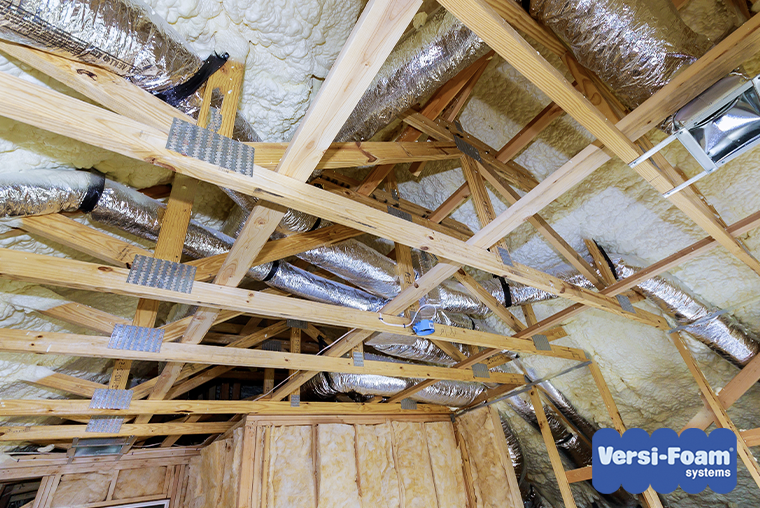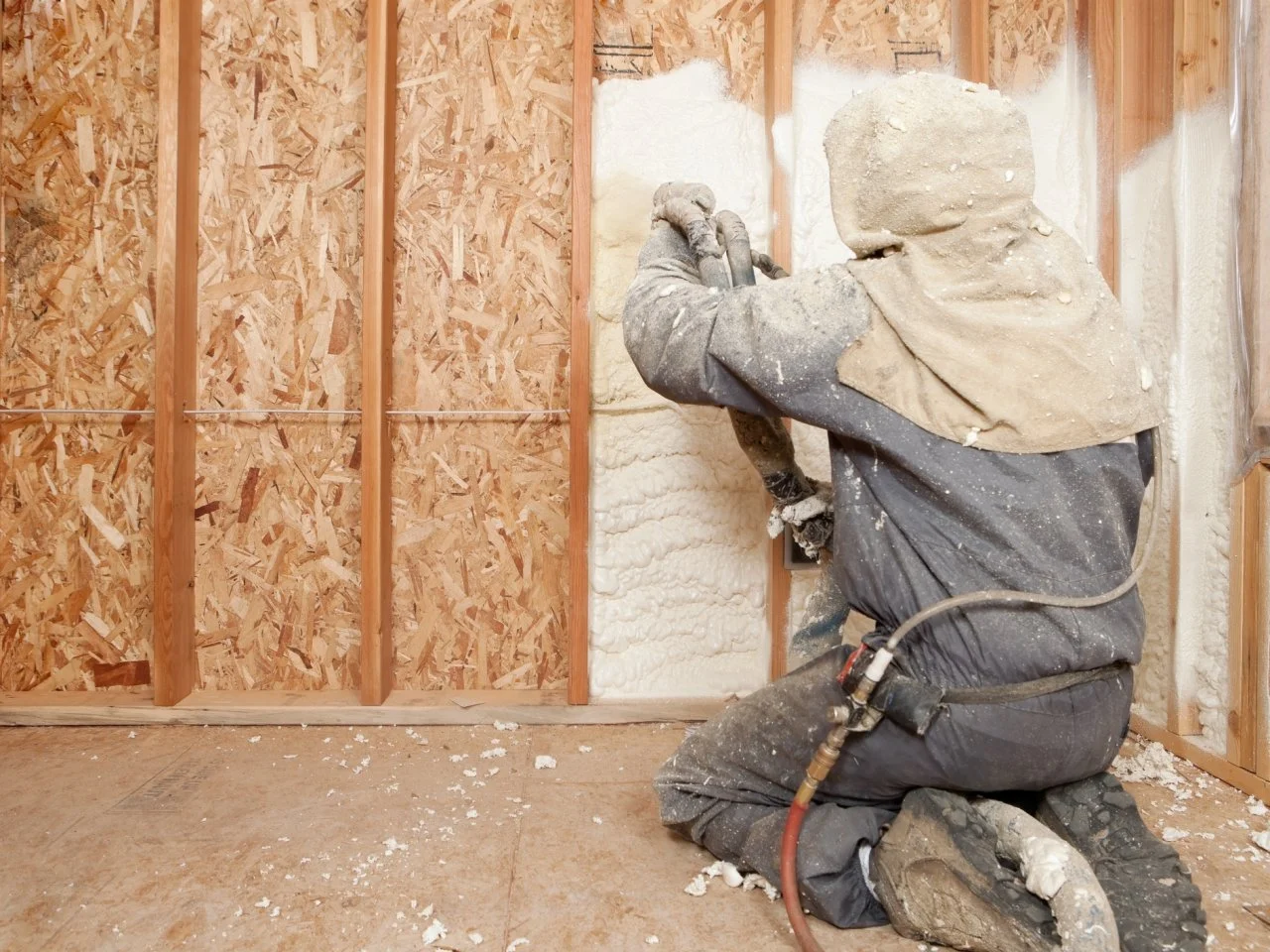Picking the Right Sort Of Spray Foam for Your Insulation Demands
Picking the Right Sort Of Spray Foam for Your Insulation Demands
Blog Article
Spray Foam: The Ultimate Option for Air Sealing and Insulation
Spray foam insulation has actually become a leading remedy for reliable air securing and thermal insulation, offering an unique mix of properties that establish it in addition to standard techniques. Its capacity to broaden and load spaces makes it especially reliable in avoiding air leakage, which can substantially affect energy effectiveness. Nonetheless, understanding the full range of its benefits, installation procedures, and comparisons with various other insulation types is critical for making notified choices. As we discover these facets, the ramifications for both brand-new constructions and retrofits end up being progressively significant. What factors should affect your choice?
What Is Spray Foam?
Spray foam is a functional insulation material that incorporates the principles of air sealing and thermal resistance to improve energy performance in buildings. Composed primarily of polyurethane or various other similar compounds, spray foam is applied as a liquid that increases upon call with surface areas, producing a solid, continual layer of insulation. This special property allows it to fill gaps, cracks, and gaps that conventional insulation materials might neglect, offering a premium air seal.
There are two main kinds of spray foam: open-cell and closed-cell. Open-cell spray foam is lighter and more adaptable, using excellent sound absorption and a lower R-value per inch - Spray Foam. On the other hand, closed-cell spray foam is denser, giving a higher R-value, dampness resistance, and added architectural integrity to building elements
The application procedure commonly includes specific devices, making certain a seamless application that abides by numerous substrates, consisting of metal, wood, and concrete. This versatility makes spray foam ideal for both brand-new constructions and retrofitting existing frameworks. Its capacity to develop an impermeable barrier significantly adds to minimizing power usage and boosting interior air quality, therefore making it a recommended option among property owners and building contractors alike.
Benefits of Spray Foam Insulation
One of the most significant benefits of spray foam insulation is its outstanding capability to develop a continuous air obstacle, which effectively decreases energy loss. Unlike typical insulation materials, spray foam broadens to fill up splits and spaces, guaranteeing that air leakage is considerably lowered. This particular not only boosts energy effectiveness yet likewise results in decrease utility costs in time.
Additionally, spray foam insulation supplies exceptional thermal resistance, adding to an extra stable indoor setting. Its high R-value per inch permits reliable insulation in constrained areas, making it perfect for attics, wall surfaces, and crawl spaces. In addition, the moisture-resistant homes of spray foam assistance stop mold and mildew growth, promoting healthier living problems.
Another important advantage of spray foam insulation is its sound-dampening high qualities (Spray Foam). It efficiently minimizes noise transmission between rooms, producing a quieter and more comfy home atmosphere. The resilience of spray foam additionally attracts attention, as it does not sag or resolve gradually, keeping its efficiency throughout its life-span
Exactly How Spray Foam Functions
Comprehending exactly how spray foam insulation works is necessary for appreciating its performance in air securing and thermal resistance. Spray foam insulation contains 2 primary parts: isocyanate and polyol material. When these parts are blended, they undergo a chain reaction that creates the product to broaden rapidly, producing a thick foam that fills up spaces, splits, and dental caries.
As the foam broadens, it follows surface areas, creating an impermeable seal that dramatically minimizes air infiltration. This characteristic makes spray foam insulation very efficient at preventing drafts and dampness infiltration, which can result in power loss and damage with time. Additionally, the closed-cell variation of spray foam uses exceptional thermal resistance because of its rigid structure, successfully decreasing warm transfer.
The one-of-a-kind buildings of spray foam allow it to comply with irregular surfaces, making sure thorough insurance coverage and a smooth barrier. As an outcome, spray foam insulation not only enhances power efficiency yet additionally adds to improved indoor air top quality by decreasing the accumulation of pollutants and allergens. Inevitably, recognizing the mechanics behind spray foam underscores its duty as a premium choice for insulation and air securing in both commercial and residential applications.
Installment Process Overview

Before setup, the room has to be sufficiently cleaned and prepped, ensuring that surfaces are without debris, dirt, and dampness. This action is critical since pollutants can endanger adhesion and total efficiency. Once the area is prepared, the application includes blending both components of the spray foam, which increases upon contact and fills up spaces successfully.
Educated experts should carry out the setup, using customized tools to make sure consistent protection and optimum density. Safety precautions, consisting of putting on protective gear and making sure proper ventilation, are crucial during this process. After application, the foam usually treatments rapidly, forming a solid obstacle that enhances power effectiveness.
Comparing Spray Foam to Standard Insulation
When reviewing insulation alternatives, spray foam insulation stands out in comparison to typical materials such as fiberglass and cellulose. Unlike fiberglass and cellulose, which can permit air infiltration, spray foam expands upon application, loading crevices and spaces to develop an impermeable seal.
Furthermore, spray foam supplies a higher R-value per inch than traditional insulation types, providing even more effective thermal resistance in a thinner profile. This particular is specifically valuable precede with restricted tooth cavity deepness. Spray foam is immune to moisture and mold and mildew growth, which can be a considerable concern with cellulose and fiberglass, especially in humid settings.
However, spray foam insulation commonly brings a higher in advance price than its typical equivalents. Property owners should consider this first financial investment against lasting power financial savings and performance advantages. Inevitably, while both insulation kinds offer their objective, spray foam arises as an advanced option for modern insulation requirements, especially in terms of air securing and thermal efficiency.

Verdict
In recap, spray foam insulation stands for a highly reliable option for attaining optimum air sealing and thermal resistance. Its special residential properties, including moisture resistance and audio dampening, make it appropriate for numerous applications in both new building and constructions and retrofitting projects (Spray Foam). Although the initial expenses might be greater compared to typical insulation products, the long-lasting benefits, such as significant energy savings and improved interior air top quality, justify the financial investment and highlight its value in contemporary structure practices.
Spray foam insulation has actually arised as a leading option for reliable air securing and thermal insulation, using an unique combination of residential properties More Bonuses that establish it apart from standard check out this site approaches.Spray foam is a flexible insulation product that incorporates the principles of air sealing and thermal resistance to improve power performance in structures.When assessing insulation options, spray foam insulation stands out in contrast to traditional materials such as fiberglass and cellulose. Eventually, while both insulation kinds serve their function, spray foam arises as an extra advanced solution for modern-day insulation demands, particularly in terms of air securing and thermal efficiency.
In summary, spray foam insulation represents a very reliable option for accomplishing optimal air sealing and thermal resistance.
Report this page